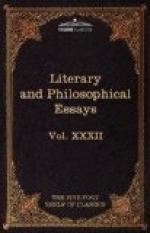The immense reputation of the Purgatory of St. Patrick filled the whole of the Middle Ages. Preachers made appeal to the public notoriety of this great fact, to controvert those who had their doubts regarding Purgatory. In the year 1358 Edward iii. gave to a Hungarian of noble birth, who had come from Hungary expressly to visit the sacred well, letters patent attesting that he had undergone his Purgatory. Narratives of those travels beyond the tomb became a very fashionable form of literature; and it is important for us to remark the wholly mythological, and as wholly Celtic, characteristics dominant in them. It is in fact evident that we are dealing with a mystery or local cult, anterior to Christianity, and probably based upon the physical appearance of the country. The idea of Purgatory, in its final and concrete form, fared specially well amongst the Bretons and the Irish. Bede is one of the first to speak of it in a descriptive manner, and the learned Mr. Wright very justly observes that nearly all the descriptions of Purgatory come from Irishmen, or from Anglo-Saxons who have resided in Ireland, such as St. Fursey, Tundale, the Northumbrian Dryhthelm, and Knight Owen. It is likewise a remarkable thing that only the Irish were able to behold the marvels of their Purgatory. A canon from Hemstede in Holland, who descended in 1494, saw nothing at all. Evidently this idea of travels in the other world and its infernal categories, as the Middle Ages accepted it, is Celtic. The belief in the three circles of existence is again to be found in the Triads, [Footnote: A series of aphorisms under the form of triplets, which give us, with numerous interpolations, the ancient teaching of the bards, and that traditional wisdom which, according to the testimony of the ancients, was transmitted by means of mnemonic verses in the schools of the Druids. under an aspect which does not permit one to see any Christian interpolation.]




